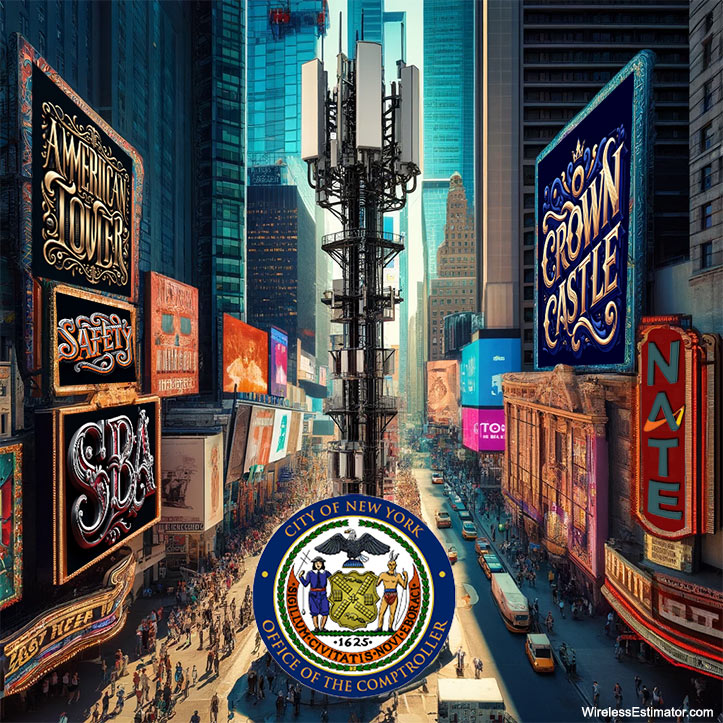
WITH A PENCHANT FOR SAFETY, New York City’s five pension funds have obtained commitments from the top three towercos to improve worker safety reporting. The velvet hammer NYC Comptroller Brad Lander used was the funds’ $223 million in stock investments. Industry observers, including management from two of the tower companies, question the city’s motivation. “What are they going to do with this information? They have no one on staff who understands this industry and can audit the findings,” said one safety executive who requested anonymity.
New York City Comptroller Brad Lander, representing the five New York City pension funds, has successfully secured agreements with leading telecommunications infrastructure firms—SBA Communications Corporation (SBA), American Tower Corporation (American Tower), and Crown Castle—to improve their reporting on worker safety at communication tower sites.
Lander emphasized the difficult conditions faced by tower workers, noting, “From dizzying heights to challenging weather conditions, tower workers risk their lives every day to keep us connected. Detailed safety protocols and reporting mechanisms are essential to address potential hazards promptly. I am pleased to announce that SBA, American Tower, and Crown Castle have committed to increased transparency and accountability regarding the safety of tower climbers, meeting investor expectations for a secure working environment at their sites.”
This is the first known incident where shareholder safety advocacy trumps financial stability, although it is unknown why this action was necessary. Two requests to the comptroller’s office for additional information were not returned. Although Lander is concerned regarding the possibility of fatalities in the city, in over two decades that Wireless Estimator has been tracking deaths and serious industry accidents, none have occurred in New York City. In addition, New York is one of the safer states in the country for wireless infrastructure workers, with only two industry deaths in over two decades.
Lander said that SBA has pledged to enhance its disclosures to outline better how its health and safety policies are applied to contractors and subcontractors at its tower sites. This will include detailing its training and certification standards for these groups, its third-party verification processes, and how its internal on-site audits complement these verifications. SBA’s disclosures will also cover safety statistics for its employees and contractor/subcontractor tower climbers, describe additional safety initiatives, and provide a mechanism for reporting safety concerns.
It is unknown what SBA’s response was to Lander’s inquiry. Still, they could have provided most of their safety policies and how they apply to contractors by sending them their 31-page contractor safety program, readily available on their website.
Lander’s statement said that American Tower is set to broaden its disclosure to specify how regulatory requirements and health and safety policies affect contractors and subcontractors working on its sites, along with the training and certification requirements. “The disclosure will elaborate on the prerequisites for engagement of contractors and subcontractors, the inspections and audits conducted to ensure compliance with safety standards, and other safety measures, including third-party audits. American Tower will also report on contractor health and safety issues and outline compliance procedures to ensure that vendors meet regulatory and qualification standards before they access tower sites. Furthermore, the company will detail its maintenance and safety programs, review safety incidents, and outline the reporting mechanisms available to site workers.”
A shareholder proposal had been sent to American Tower by the New York City Retirement System. The proposal, intended for inclusion in American Tower’s proxy materials for their upcoming annual meeting, was aimed at enhancing disclosures regarding worker safety at communications tower sites.
The initial proposal called for a third-party audit of American Tower’s safety practices and their impact on workers, including contractors. It was expected to be shared publicly on the company’s website. American Tower had sought to exclude this proposal from their proxy materials, citing already substantially implemented safety measures and claiming the proposal touched on ordinary business matters, which are generally excludable under SEC rules.
Landers said Crown Castle has also agreed to expand its disclosure concerning contractors and subcontractors. This will include information on mandatory notifications when technician services are needed at a site, qualification and registration requirements, safety team audits and inspections, and a reporting mechanism for safety concerns. Crown Castle’s disclosure will also provide safety statistics for all tower technicians, including those contracted on its sites.
Almost all of the disclosures requested have been readily available and, in most instances, exceed the parameters set by Lander’s office. All three towercos are active members of NATE: The Communications Infrastructure Contractors Association, which has become the bedrock of safety training, research, reporting and advocacy for industry workers. The three towercos have all collaborated to create a hazard recognition program aimed at carriers, broadcasters, and tower owners, as well as being active in the National Wireless Safety Alliance (NWSA) and the Telecommunications Industry Registered Apprenticeship Program (TIRAP).
In addition, the towercos have been leading contributors in developing safety standards.
As of February 29, 2024, the five pension funds hold investments valued at $34.4 million in SBA, $120.9 million in American Tower, and $67.8 million in Crown Castle
















